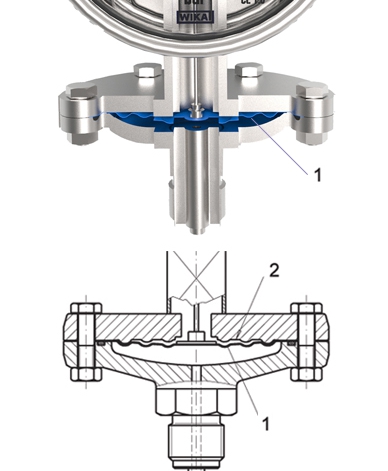
Overload can quickly expose the limit of any pressure measuring instrument. Diaphragm pressure gauges withstand a significantly higher maximum pressure when compared to instruments with Bourdon tubes. This protection is due to their physical design.

The high overload safety results from the support of the diaphragm (1) on the upper flange and its contour from flattened waves. With measuring ranges in the mbar range, the protection is increased through a specially machined diaphragm bed, against which the diaphragm rests completely (2).
A cross-section of the measuring cell illustrates the reason for the pronounced overload safety of a diaphragm pressure gauge: Its diaphragm can be supported against the upper flange. Furthermore, since the diaphragm features a contour with flattened waves, the protection factor is further increased because of the greater contact area. Diaphragm pressure gauges from WIKA have a standard overload safety of five times the full scale value − with Bourdon tube pressure gauges, this is only around 1.3 times as standard.
No deformation
The overload safety of diaphragm element instruments can still be increased up to one thousand times. Up to 400 bar is possible, even with a measuring range of 0 … 16 mbar. In this case, the upper flange has a specially machined, metallic diaphragm bed, against which the diaphragm element rests, should the full scale value be exceeded. Through this full-surface contact, any plastic deformation is excluded and the long-term stability is increased. For mbar measuring ranges, from the same resistant-to-deformation approach, safety against underpressure is also possible. Diaphragm elements are generally not flat. Only a contour with concentric waves enables a diaphragm travel (necessary for mechanical measurement) of one to three millimetres in length, alongside good linearity.
Note
You can find further information on diaphragm pressure gauges on the WIKA website under the headings Pressure gauges, Pressure gauges with output signal and Contact pressure gauges.
See also our article
Advantages of diaphragm pressure gauges (1): Measurement of low pressures

